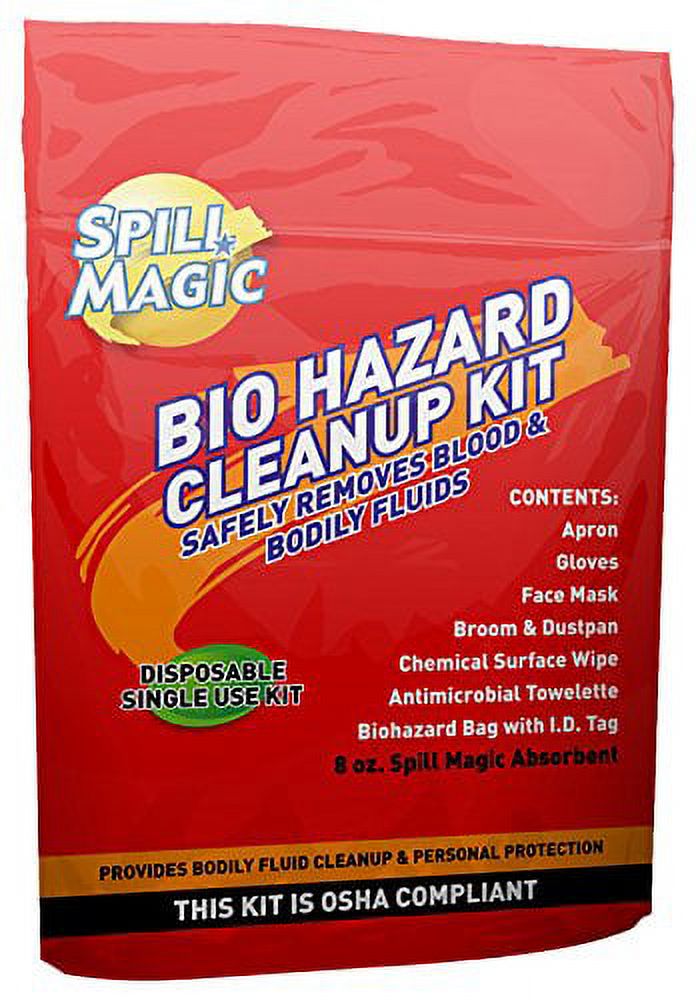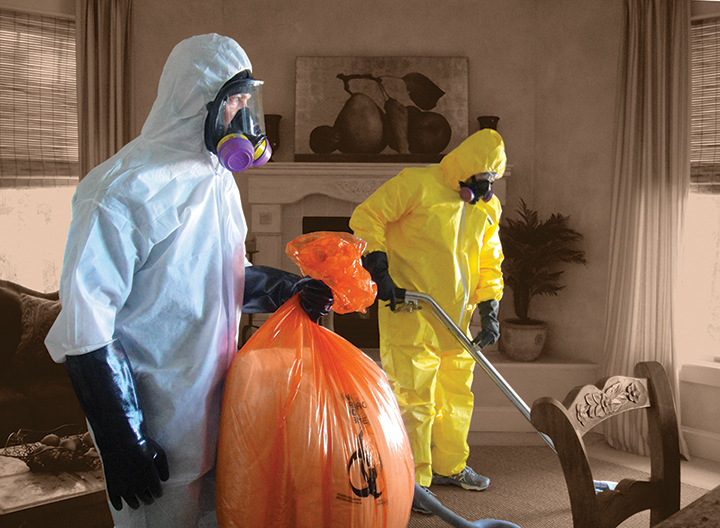Professional Blood Cleanup: Making Sure Safe and Thorough Purification
Specialist Biohazard Cleansing and Purification for Blood, Bodily Fluids, and Hazardous Products
In the world of biohazard cleaning and decontamination for blood, bodily liquids, and harmful materials, precision and knowledge are critical. The possible wellness dangers associated with direct exposure to biohazards highlight the crucial need for thorough handling and complete clean-up. Specialized training equips specialists with the understanding and skills essential to attend to these dangerous situations successfully. However, it is not just regarding tidying up; the relevance of utilizing proper purification techniques can not be overemphasized. As we navigate the intricate landscape of biohazard cleaning, understanding the subtleties of guidelines, compliance, and the customized devices at play becomes imperative in ensuring a extensive and safe purification process.
Health And Wellness Risks of Biohazard Exposure
Direct exposure to biohazards positions substantial health dangers that can lead to serious effects for individuals and neighborhoods alike. Biohazards incorporate a wide variety of organic substances, including blood, bodily liquids, mold and mildew, microorganisms, infections, and various other possibly transmittable materials. When individuals come into contact with these biohazards, whether through accidents, improper handling, or ecological direct exposure, they encounter the threat of having severe health problems or illness.
One of the primary health risks related to biohazard exposure is the transmission of infectious conditions. Bloodborne pathogens such as HIV, liver disease B and C, and various germs can be existing in biohazardous products, posing a straight danger to human health and wellness. Inhaling airborne biohazards like mold and mildew spores or entering contact with contaminated surface areas can likewise result in respiratory concerns, allergic reactions, and other adverse wellness impacts.
Additionally, biohazard direct exposure can have lasting wellness ramifications, with some diseases showing up years after the preliminary contact (Blood Cleanup). Therefore, it is critical to focus on proper biohazard cleansing and decontamination to minimize these health and wellness risks and make sure the safety of people and communities

Specialized Training for Biohazard Cleaning
When it comes to dealing with biohazard cleaning efficiently and safely, specialized training plays an essential duty in ensuring appropriate purification treatments are followed. Biohazard cleanup needs certain expertise and abilities to effectively alleviate threats related to bloodborne pathogens, bodily fluids, and harmful products. Specialists learnt biohazard cleanup undergo rigorous instruction on exactly how to safely manage, eliminate, and take care of biohazardous products to prevent contamination and exposure.
Specialized training for biohazard cleanup covers a variety of vital topics, including appropriate personal protective equipment (PPE) usage, bloodborne pathogen awareness, decontamination strategies, and unsafe waste disposal methods. People educated in biohazard cleaning are furnished with the needed knowledge to evaluate contamination levels, identify potential risks, and execute suitable cleanup treatments in conformity with governing requirements.
Constant training and education are vital in the field of biohazard cleanup to stay upgraded on the most current decontamination technologies, safety and security methods, and laws. By purchasing specialized training, biohazard clean-up professionals can properly react to emergency cleanup scenarios and secure both public health and wellness and the atmosphere.
Importance of Correct Decontamination Techniques
Making use of correct decontamination methods is essential in biohazard cleanup to properly minimize and get rid of dangerous products health threats. Reliable purification not only makes certain the removal of noticeable traces of blood, bodily liquids, and various other biohazards however additionally targets unnoticeable virus that may present severe health dangers otherwise correctly gotten rid of. By complying with rigorous decontamination procedures, educated professionals can dramatically reduce the danger of direct exposure to dangerous bacteria, infections, and bacteria that could result in infections or conditions.
Proper purification strategies entail using specific devices and anti-bacterials that are specifically developed to reduce the effects of biohazards properly. Extensive cleansing and sanitation of infected locations are important to avoid the spread of microorganisms and make certain other a secure setting for occupants. Additionally, the appropriate disposal of biohazardous waste complying with purification treatments is crucial in protecting against contamination of various other surface areas or people.

Tools and Devices for Safe Cleanup
When dealing with blood, physical fluids, or harmful products, biohazard cleaning experts count on specialized gear to lessen exposure dangers and thoroughly sanitize the affected area. In addition, biohazard cleaning kits having disinfectants, absorbent products, and biohazard bags are made use of to safely include and get rid of of contaminated products.
Advanced cleansing devices like hospital-grade disinfectants, HEPA-filtered vacuums, and fogging makers are used to disinfect surfaces and remove biohazards successfully. Specialized tools such as sharps containers and biohazard garbage disposal bins are utilized to safely manage sharp items and biohazardous waste products. By using the appropriate tools and devices, biohazard cleaning professionals can guarantee a detailed cleanup process that prioritizes safety and minimizes health risks for both workers and passengers of the afflicted area.
Laws and Compliance in Biohazard Cleaning
Appropriate adherence to policies and compliance standards is critical in biohazard cleaning to ensure the safety of both personnel and the environment. Federal government firms such as OSHA (Occupational Safety And Security and Wellness Administration) and the EPA (Environmental Defense Firm) have established specific standards for biohazard cleaning treatments to reduce health risks browse around this web-site and ecological contamination. These laws cover a variety of elements including the handling, transportation, and disposal of biohazardous products, along with the required training and protective equipment needed for workers involved in the cleaning procedure.
Biohazard cleansing business must stay updated with these laws to ensure that their operations satisfy the called for safety and security criteria. Failure to abide by these regulations can cause severe repercussions, consisting of fines, lawsuit, and threatening the wellness of people and visit this site the setting. By following stringent guidelines and compliance actions, biohazard cleaning business can effectively alleviate risks and ensure a risk-free and complete cleanup process for all celebrations included.
Final Thought
Finally, biohazard cleansing and decontamination need specialized training, proper methods, and adherence to guidelines. Exposure to blood, bodily fluids, and unsafe products postures significant wellness threats, making it important to make use of the right devices and devices for secure cleanup. By complying with rigorous methods and guidelines, experts can successfully minimize the dangers related to biohazard exposure and make certain the safety and security of both themselves and others.
As we navigate the elaborate landscape of biohazard clean-up, recognizing the subtleties of laws, compliance, and the specialized equipment at play ends up being imperative in making sure a comprehensive and risk-free decontamination process. (Blood Cleanup)
When it comes to managing biohazard cleaning efficiently and securely, specialized training plays a fundamental role in ensuring proper purification treatments are adhered to.Making use of correct purification methods is vital in biohazard clean-up to successfully reduce and eliminate hazardous products wellness dangers. Furthermore, biohazard cleaning kits containing disinfectants, absorbing products, and biohazard bags are utilized to safely contain and get rid of of contaminated things.
Federal government companies such as OSHA (Occupational Security and Health And Wellness Administration) and the EPA (Environmental Defense Company) have developed certain guidelines for biohazard cleanup treatments to lessen health threats and ecological contamination.